Posts Tagged ‘Japanese Americans’


The National WWII Museum is saddened to learn of the passing of another hero, Ben Kuroki, who died at age 98 on September 1, 2015. Over the years, we have been honored to have Mr. Kuroki here for the opening of the Road to Berlin in December 2014 and in our previous special exhibit From Barbed Wire to Battlefields: Japanese American Experiences in WWII.
-
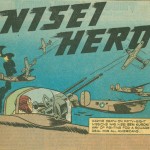
- Comic about Kuroki "Nisei Hero" from the Collection of The National WWII Museum
-
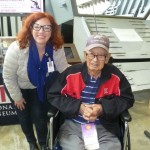
- Kuroki and Curator Kim Guise at The National WWII Museum
-
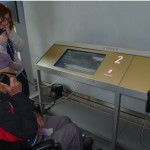
- Kuroki and Curator Kim Guise listen to and watch Kuroki's storiy in the Dog Tag Experience at The National WWII Museum
-
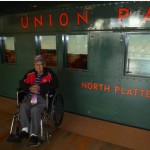
- Kuroki in front of the Nebraska labelled train car at The National WWII Museum
-
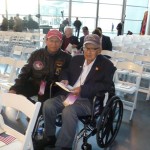
- Kuroki and friend Joe Duran at The National WWII Museum
-
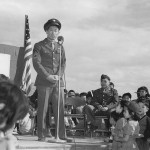
- Kuroki speaking at Heart Mountain War Relocation Center , April 24, 1944. Courtesy National Archives
Nebraska native Ben Kuroki volunteered days after Pearl Harbor, but was rejected by the Army because of ancestry. Months later, he was inducted into the Army Air Corps, slipping through on a technicality. In 1942, Kuroki fought to be sent to Europe as a clerk with the 8th Air Force. There, with a shortage of aerial gunners, Kuroki became part of a crew. He flew 30 combat missions in Europe including raids on the Ploesti oil fields. Upon returning to the US, Kuroki was asked to visit Topaz, Heart Mountain and Minidoka with recruiters trying to solicit Nisei volunteers. Seeing American citizens like him under armed guard was a shock that Kuroki would never get over. After receiving special permission from Secretary of War Henry Stimpson, Kuroki flew 28 missions with the 20th Air Force over Japan. His crew named their B-29 “Sad Saki” in honor of Kuroki, who they termed “Most Honorable Son.”
His quiet determination, courage, and humility are his legacy. Every day at the Museum, Kuroki’s legacy lives on as visitors to the Museum follow his life during World War II in our interactive Dog Tag Experience.
He was an inspiration to all who came in contact with him, and he will be missed.
Ben Kuroki’s oral history interview conducted by Museum Historian Tom Gibbs in 2013 (one of Mr. Kuroki’s last) can be viewed in our Digital Collections.
Post by Curator Kimberly Guise.



We are in the closing days for our Special Exhibit, From Barbed Wire to Battlefields: Japanese American Experiences in WWII at the National WWII Museum. Stay tuned for a traveling version of this show that we hope will bring this story to new audiences. Last week we received a visit from someone with intimate knowledge of the subject, the little girl seated fifth from the left in the front row. This photo is of the Nursery Class I in Jerome Relocation Center in May 1944. Jerome housed 2,483 school age children, thirty-one percent of the total population. The photo is surprising, as it goes against the notion that all of the children in the camp schools were Japanese American or at least visibly identifiable as such. Some of the children may have been local children or children of the WRA personnel. We are seeking more information about this photo and about children who attended school in any of the WRA camps. If you have artifacts, photographs, or stories related to Japanese American experiences in WWII, we invite you to share them with us. Visit our special exhibit show here at the Museum by October 12, 2014.
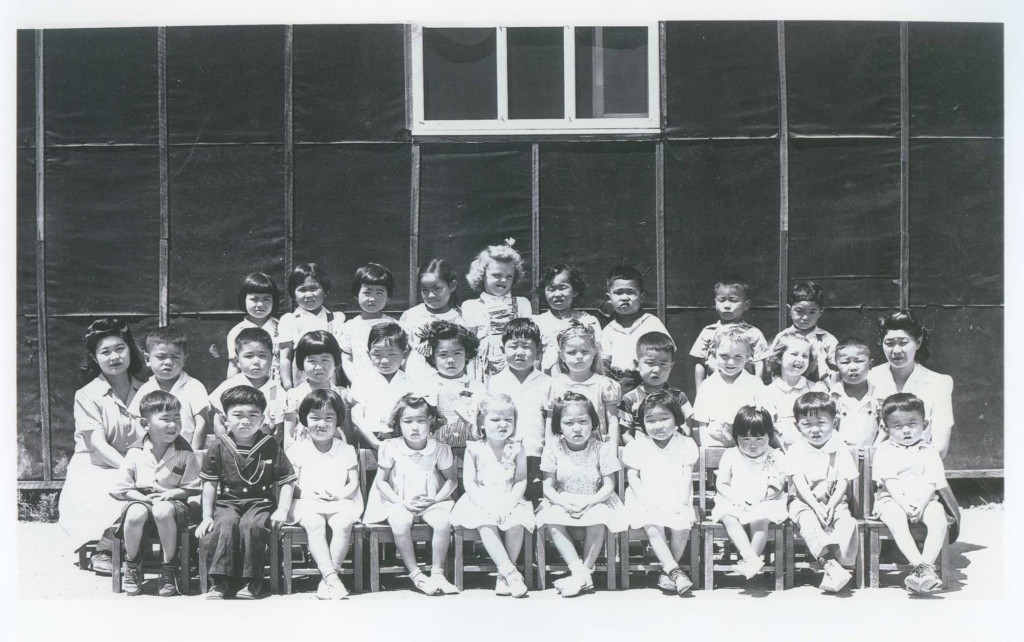
Jerome Relocation Center, 1944. Courtesy of Marcella Lecky.



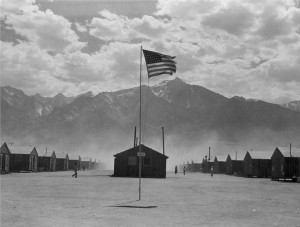
Flag at Manzanar, 3 July 1942. Photo by Dorothea Lange.
Dorothea Lange died on 11 October 1965. Today would have been her 119th birthday. Born in Hoboken, New Jersey, Lange became one of the pioneers of documentary photography. Some of her most well-known work was set in the American West, including her photographs during the Great Depression and WWII.
In March 1942, Dorothea Lange—already a well-known photographer—was one of several hired by the War Relocation Authority (WRA) to photograph the removal of Japanese Americans from the West Coast documenting their transportation into “assembly centers” and then more permanent “relocation centers.” In 1942 and 1943, Lange traveled hundreds of miles, attempting to follow individuals through the experience, spotlighting families and shooting over 800 images of this sad chapter of American history. Ultimately, Lange was required to turn over every negative to the WRA and her photographs were marked “Impounded” and remained unseen for decades.
A selection of these photographs can be seen in our current special exhibit, From Barbed Wire to Battlefields: Japanese American Experiences in WWII and on our companion website in our Dorothea Lange image gallery.
Happy Birthday, Dorothea Lange. Thank you for these images.
Post by Curator Kimberly Guise.



Today marks the 30th anniversary of the death of Ansel Adams. The acclaimed nature photographer, born in San Francisco in 1902, died on 22 April 1984. Adams was active during WWII and some of his work is featured in our current special exhibit, From Barbed Wire to Battlefields: Japanese American Experiences in WWII.

Birds on wire, evening, Manzanar Relocation Center by Ansel Adams. Courtesy of the Library of Congress.
During the fall of 1943, Ansel Adams shot over 200 images in Manzanar Relocation Center. Many of these images were published in 1944 in the book Born Free and Equal. The images are all courtesy of the Library of Congress and the entire series can be viewed here in their online catalog. When Adams offered his Manzanar series to the Library of Congress in 1965, he commented on the collection of images in a letter: “The purpose of my work was to show how these people, suffering under a great injustice, and loss of property, businesses and professions, had overcome the sense of defeat and dispair [sic] by building for themselves a vital community in an arid (but magnificent) environment….All in all, I think this Manzanar Collection is an important historical document, and I trust it can be put to good use.”
Post by Curator Kimberly Guise.



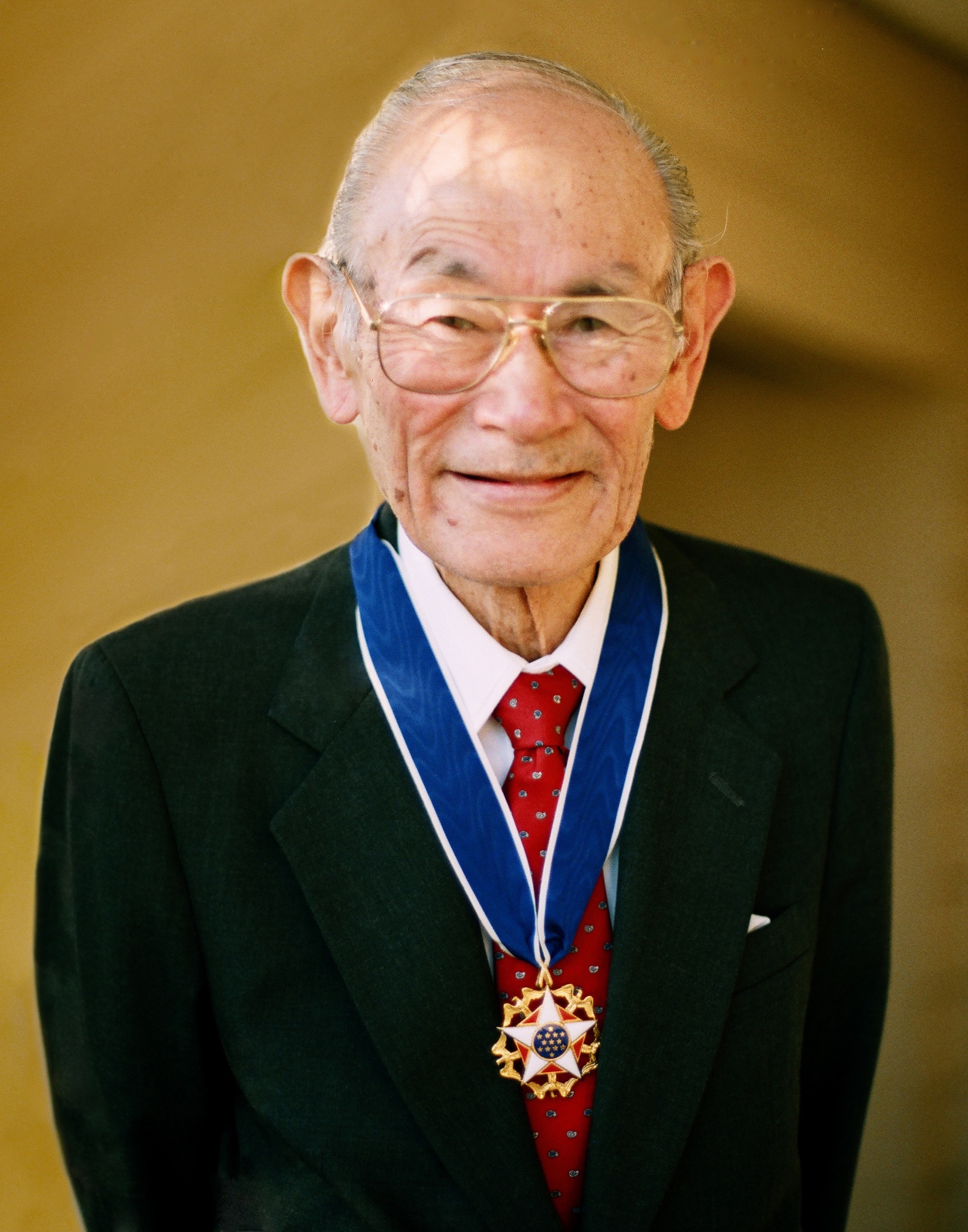
Courtesy of the Korematsu Institute
Today several states are celebrating Fred Korematsu Day. Established first in 2011, “Fred Korematsu Day of Civil Liberties & the Constitution” honors the legacy of Fred Korematsu, who resisted to the Japanese American incarceration during WWII. Instead of reporting to authorities in early 1942 for removal outside of the Exclusion Zone established by the government, the 23 year old welder stayed in Oakland with his Italian American girlfriend and even had plastic surgery on his eyes in an attempt to avoid recognition. He was arrested in May 1942 and eventually sent to Topaz War Relocation Center in Utah. Working with the American Civil Liberties Union, Korematsu sued the government challenging the imprisonment without trial of Japanese Americans. They appealed their case all the way to the Supreme Court, which, ultimately rejected Korematsu’s argument in a 6-to-3 decision that still stands, upholding the government’s right to intern its citizens. Although in recent decades, Korematsu has become a figure of resistance and standing up for civil liberties (he received the Presidential Medal of Freedom from President Clinton in 1998), the Supreme Court’s 1944 ruling in Korematsu v. United States has never been overruled. To learn more about Korematsu, visit the Fred T. Korematsu Institute for Civil Liberties and Education.
The National WWII Museum hosted a special exhibit in 2014 which highlighted the experiences of Japanese Americans during World War II like Korematsu. Learn more about the exhibit From Barbed Wire to Battlefields: Japanese American Experiences in WWII.
Post by Curator Kimberly Guise.














